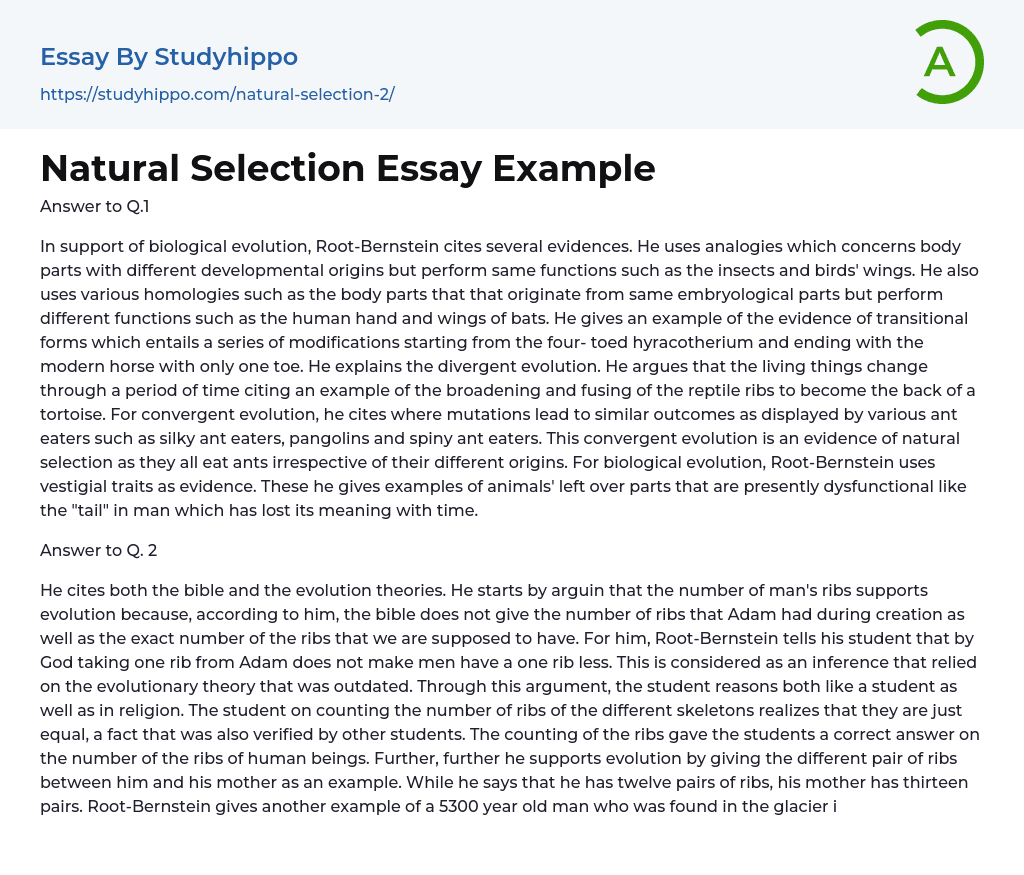Answer to Q.1: In support of biological evolution, Root-Bernstein provides several pieces of evidence. He uses analogies, such as comparing the wings of insects and birds, which have different developmental origins but serve the same functions. Additionally, he discusses homologies, where body parts may have originated from the same embryological structures but have different functions, such as the human hand and bat wings. He also mentions transitional forms, which illustrate a series of modifications from ancestral species to present-day species, such as the evolution of the horse from the four-toed hyracotherium. Root-Bernstein explains divergent evolution, where living organisms change over time, using the example of reptile ribs transforming into the shell of a tortoise. He also discusses convergent evolution, where mutations lead to similar outcomes in unrelated species, providing examples such
...as silky ant eaters, pangolins, and spiny ant eaters who all eat ants despite their different origins. Finally, Root-Bernstein uses vestigial traits as evidence for biological evolution, highlighting leftover body parts in animals that have lost their function over time, such as the "tail" in humans.
Answer to Q.2: Root-Bernstein incorporates both biblical and evolutionary theories as sources of evidence.The text begins with the argument that the number of ribs in humans supports evolution. According to the individual, the Bible does not specify the number of ribs Adam had during creation or the exact number of ribs humans are supposed to have. This argument is based on an outdated inference made by Root-Bernstein that taking one rib from Adam does not result in men having one rib less. The student uses both scientific and religious reasoning in this argument.
The student then counts the number o
ribs in different skeletons and discovers that they are all equal, which aligns with what other students have also observed. Counting the ribs provides an accurate answer to the number of ribs in human beings. The student further supports evolution by giving an example of the different number of rib pairs between himself and his mother. He claims to have twelve pairs of ribs while his mother has thirteen pairs. Another example given by Root-Bernstein is a 5300 year old man found in a glacier in the Alps who had eleven pairs of ribs. These anatomical differences, according to Root-Bernstein, support and drive evolution.
In response to question 3, Lamarck's hypothesis on acquired characteristics is mentioned, which was deemed incorrect.Lamarck proposed that organisms have the ability to choose their traits, which then change to help them adapt to their immediate environment. He also claimed that if an organism changes its acquired traits, these new traits are passed on to its offspring. This hypothesis contrasts with the ideas of natural selection put forth by Wallace and Darwin. According to Wallace and Darwin, certain variations are present in organisms from birth, which provide advantages for members of a species to survive in a specific environment. These organisms reproduce and pass on traits to their offspring, resulting in slight variations over time and the acquisition of new traits by new species. The difference between Lamarck and Darwin's baseline is that Lamarck believes organisms do not choose their traits, as they are born with or without an advantage. Furthermore, Lamarck used speculations in his evolutionary theories, while Wallace and Darwin relied on observable phenomena to explain the process of natural
selection. In conclusion, reconciling the two theories of evolution and creation requires a deep understanding and consideration of both perspectives. While Christians may believe in the creation theory from the Bible, it is important to also consider the biological explanation of evolution, as there are practical and observable features supporting this theory.
- Oxygen essays
- Atmosphere essays
- Coral Reef essays
- Desert essays
- Earth essays
- Ocean essays
- Lake essays
- Sea essays
- Biodiversity essays
- Natural Environment essays
- Forest essays
- Soil essays
- Water essays
- Rainbow essays
- Ecosystem essays
- Volcano essays
- Wind essays
- Forestry essays
- Bottled Water essays
- Agriculture essays
- Albert einstein essays
- Animals essays
- Archaeology essays
- Bear essays
- Biology essays
- Birds essays
- Butterfly essays
- Cat essays
- Charles Darwin essays
- Chemistry essays
- Dinosaur essays
- Discovery essays
- Dolphin essays
- Elephant essays
- Eli Whitney essays
- Environmental Science essays
- Evolution essays
- Fish essays
- Genetics essays
- Horse essays
- Human Evolution essays
- Isaac Newton essays
- Journal essays
- Linguistics essays
- Lion essays
- Logic essays
- Mars essays
- Methodology essays
- Mineralogy essays
- Monkey essays




